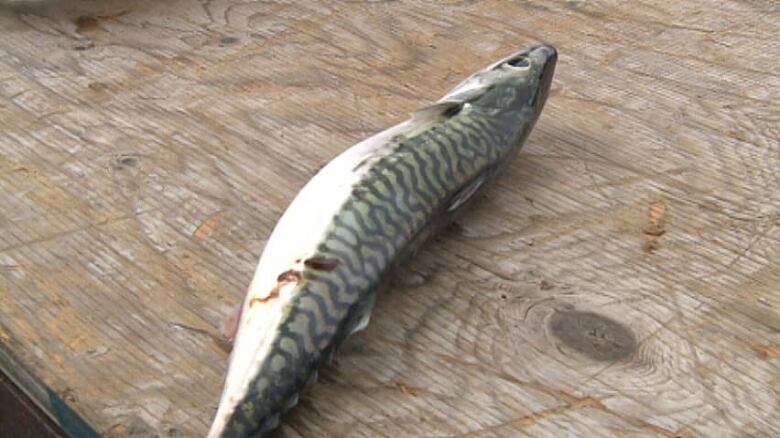Industry challenges DFO's assessment of Atlantic mackerel stocks
'It certainly doesn't reflect what the fishermen are seeing in the water'

A bleak Canadian government assessment of the Atlantic mackerel population is too pessimistic according to some in the Nova Scotia fishing industry.
"It certainly doesn't reflect what the fishermen are seeing in the water,' says Ryan Langille, a bait buyer in Pictou, N.S.
The recent Department of Fisheries and Oceans assessment places the region's Atlantic mackerel spawning stock biomass in the "critical zone," meaning it is in decline and must be rebuilt.
Scientists say the spawning population is down 86 per cent from pre-2000 levelsand the number of fish surviving to breed is at all-time lows.
Mackerel is the primary source of bait in the region's lobster fishery.
"We've had an immense amount of juvenile fish in the population and every year going forward since 2015 we notice more and more juvenile fish prevalent in the catch," Langille said. "So it's certainly not reflective of a species that's not spawning."
He is not alone.
The Maritime Fishermen's Union and fishing interests in Newfoundland and Labrador have also disputed the assessment. They say they are seeing large numbers of mackerel.
Claims a key survey is flawed
Langille questions the DFO egg and larvae survey of the primary mackerel spawning ground in the southern Gulf of St Lawrence, which is used to help estimate population.
He argues the survey is carried out too early and does not sufficiently measure later spawning elsewhere in the Gulf when temperatures are warmer.
"The egg capture that they've been finding in water temperatures above 10 degrees are reflective of the same amount of capture that they found in the 1980s when the spawning stock was very healthy," said Langille.
"So it leads me to believe that if they just waited until the water temperature was 10-11 degrees that they would have significantly more capture."
Central Nova Liberal MP Sean Fraser said he's heard similar complaints from many other fishermen in recent years who say mackerel, while smaller, are abundant. He said a second look at the survey is in order.
"I've actually taken the opportunity to speak to the fisheries minister about this proposal and we've discussed that it needs to be looked into a little further," he said.
"We need to get better data to demonstrate either that, yes, the fish stocks are as bad as DFO thinks they are or, no, they're just showing up at a different time of year."
Still,Fraser expects this years mackerel quota to reflect the dire warnings issued by the scientists. Last year, the quota for the entire region was 10,000 metric tonnes.
DFO scientist responds
The lead author of the recent DFO assessment defends the science used to estimate the mackerel spawning stock.

Biologist Andrew Smith said there used to be an egg survey in both June and July in the Gulf, but the July survey was discontinued because of the sparse amount of mackerel eggs found.
He said mackerel samples collected through May and July allow the department to determine when they are ripe and ready to spawn and calculate the beginning, peak and end of the spawning season.
A measurementknown as the gonadosomatic index, which describes sexual maturity, is used in addition to the egg survey to calculate the daily egg production, and the total egg production, over the entire spawning season.
"Ryan's claims that we aren't taking later spawning into account is a misunderstanding on his part that we have tried to communicate with him and other harvesters for years," Smith said.
Smith said the egg survey is one piece of information used in the model that estimates the spawning stock biomass.
The model "is informed much more by catch-at-age data from the commercial fishery and fisheries independent samples."
DFO on surveys, small fish and seals
Smith said DFO has also done multiple exploratory surveys over the years at the request of stakeholdersin Newfoundland and the Scotian shelfand each time these surveys turned up a small amount of mackerel eggs to none at all.
As a major nursery for mackerel it's not surprising that small mackerel will be seen in the Gulf , he said, but since they are not sexually mature they do not contribute to the spawning stock.
Langille argues the exploding population of grey seals in the region and not fishing pressure is a more likely explanation for a depressed mackerel population.
Smith said studies have shown mackerel is not a significant part of the seal diet.












_(720p).jpg)


 OFFICIAL HD MUSIC VIDEO.jpg)
.jpg)



























































































